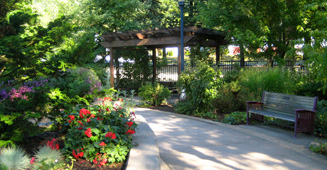
A Living Reminder

Contributor

[sidebar]For more information and a side show of images visit Portland Memory Garden[/sidebar]
In 1999, the American Society of Landscape Architects (ASLA) marked its centennial anniversary by creating 100 parks in 100 cities across the United States. This led to the creation of the Portland Memory Garden, one of eight demonstration gardens especially designed for older adults and those living with Alzheimer’s disease or other forms of dementia, and one of only two such “memory gardens” in the United States built on public land.
Not to be confused with memorial gardens that honor individuals who have died, a memory garden is designed to provide sensory stimulation for older adults with memory disorders and respite for their caregivers. The goal is to create a safe environment that also serves to spark memories of the past. Because fragrance is such a strong trigger, old-fashioned plants like climbing roses, lilacs, geraniums, and herbs help evoke memories, initiate dialogue, and enhance social interaction.
In addition to the ASLA, many different organizations came together to make the Portland Memory Garden a reality, including landscape architects and designers with experience in planning therapeutic gardens, as well as a horticultural therapist, an environmental psychologist, and experts in Alzheimer’s disease. Together they worked closely with the area’s neighborhood associations to develop a design that was responsive to the needs of their community.

Friends of the Portland Memory Garden was informally founded in 2001 as a small group of volunteers and was incorporated as a non-profit organization in 2008. The current executive board includes several registered horticultural therapists as well as a landscape architect. Besides maintaining the garden, the Friends organize volunteer work parties and sponsor programs designed to educate caregivers about the techniques and benefits of horticultural therapy.
Everyone can use and enjoy a memory garden, but some design features are specifically directed toward the elderly and those living with memory disorders. A black-railed metal fence with a single gated entrance surrounds the Portland Memory Garden, providing a sense of safety and security. Wide, tinted concrete sidewalks reduce reflected glare from the sun and allow easy mobility for walkers and those in wheelchairs. Pathways form loops for interesting strolls with no confusing dead-ends. Raised beds offer access to the plants and easy viewing for those in wheelchairs or with compromised vision. Ample seating on the raised beds and benches offer resting places in sun and shade as well as a wheelchair-accessible picnic table under a shady arbor. A centrally located pavilion serves as an orientation point, further enhancing a sense of security. The garden also includes a public restroom and drinking fountains.
[pullquote]When you take a flower in your hand and really look at it, it’s your world for the moment.
– Georgia O’Keefe[/pullquote]
The heart of the garden, however, lies in the plantings and horticultural selections. The botanical collection consists of plants that provide four seasons of interest and sensory stimulation as they spark pleasant memories of the past. In the winter months, viburnum, winter camellias, and red-twigged dogwoods work their magic. Twice a year, Portland Parks and Recreation provide hundreds of annuals such as red geraniums, daisies, and dahlias that are planted by volunteers to keep plantings fresh. And, because visitor safety is the highest priority, plant toxicity is a major consideration, as is the commitment to avoiding pesticides.
Over the past decade, a growing body of evidence demonstrates that just sitting in a garden and looking at the flowers can be therapeutic, restoring, and healing. The American Horticultural Therapy Association (ahta.org) describes the benefits of involvement in horticultural activities and exposure to nature, listing them as cognitive, psychological, social, and physical. Specific benefits for older adults include reduced use of drugs for anxiety or stress, improved sleep patterns, and better balance.
As gardeners, we know that staying connected to plants and nature is therapeutic, enlivening, and restorative. The Portland Memory Garden stands as a vivid reminder that the design of a garden and the plants that are cultivated can be tailored to meet specific needs as we age.











Responses